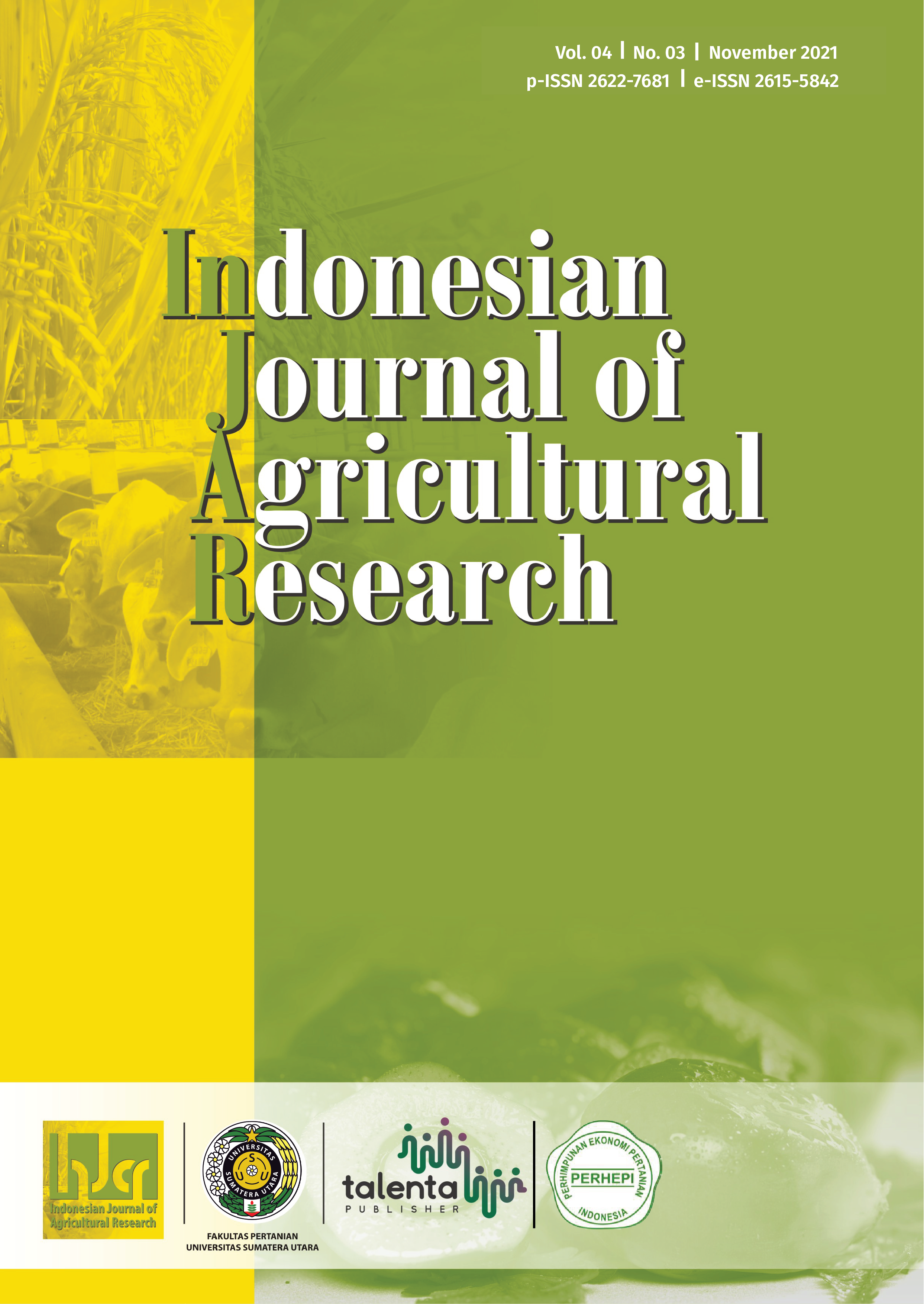Cost Efficiency of USAID Markets II Beneficiary Smallholder Rice Farmers in Nigeria’s Kano State
DOI:
https://doi.org/10.32734/injar.v4i3.6178Keywords:
cost, economies of scale, efficiency, Nigeria, USAID MARKETS IIAbstract
The present research attempted to address cost inefficiency of USAID MARKETS II smallholder farmers in Nigeria’s Kano State using farm survey data obtained from 189 farmers through a multi-stage sampling technique. The farm survey data were elicited viz. well-structured questionnaire coupled with interview schedule during the 2018 cropping season. The collected data were analyzed using both descriptive and inferential statistics- stochastic cost frontier function. The empirical evidence showed that none of the technical unit was cost efficient and this owed majorly to extension gap given its interwoven link with risk inducing factors. Besides, only 57.7%, marginally above half of the sampled technical units were fairly cost efficient i.e. close to the optimum minimum cost preferred for the production process. On the average, a technical unit wasted 14.7% of its actual incurred cost which translates to N1100 ($3.7) relative to the best practiced farmers facing the same technology and producing the same output. Therefore, since the farmers still have the room to eliminate the extra cost incurred, the study advice the program to explore further the advisory services offered to the farmers, thus addressing the extension gap that inhibited the farmers’ cost efficiency. The sustainability of the project in the near future in the absence of the advisory services especially farmer-2-farmer extension services if not explored is unlikely.
Downloads
References
World Bank, “Agriculture, forestry, and fishing, value added (% of GDP). Retrieved from The World Bank –Data,†Available:: https://data.worldbank.org/indicator/NV.AGR.TOTL.ZS?locations=NG, [Accesssed 2017a].
World Bank, “Employment in agriculture (% of total employment) (modeled ILO estimate). Retrieved from The World Bank – Data,†Available:: https://data.worldbank.org/indicator/SL.AGR.EMPL.ZS?locations=NG, [Accessed 2017b].
World Bank, “Poverty headcount ratio at $1.90 a day (2011 PPP) (% of population). Retrieved from The World Bank – Data,†Available:: https://data.worldbank.org/indicator/SI.POV.DDAY?locations=NG, [Accessed: 2009].
P. McNamara, L. Gertner, and C. Merten, USAID/Nigeria markets II ex-post study (A report of USAID/Nigeria). Washington DC: Chemonic, 2019.
K. Schubert and J. Mason, Cost-benefit analysis of USAID/Nigeria’s MARKETS II Program (A final report prepared for Nigeria mission). Washington DC: USAID, 2015.
H. U. Nwalieji, M. C. Madukwe, A. E. Agwu, and E. Matthews-Njoku, “Impact of the United States Agency for International Development (USAID) Rice Project Phase 1 on rice farmers in Anambra and Ebonyi States, Nigeria,†Asian Journal of Agricultural Extension, Economics and Sociology, vol.9, no.4, pp. 1-11, 2016.
M. S. Sadiq, I. P. Singh, and M. M. Ahmad, “Cost efficiency status of rice farmers participating in IFAD-VCD programme in Niger state of Nigeria,†Moroccan Journal of Agricultural Science, vol.1, no.6, pp. 317-322, 2020.
P. Paudel and A. Matsuoka, “Cost efficiency estimates of maize production in Nepal: A case study of the Chitwan District,†Agricultural Economics-Czech, vol. 55, no.3, pp. 139-148, 2009.
K. Ogundari, S. O. Ojo, and I. A. Ajibefun, “Economics of scale and cost efficiency in small scale maize production: Empirical evidence from Nigeria,†Journal of Social Sciences, vol.13, no.2, pp. 131-136, 2006.
M.S. Sadiq and I.P. Singh, “Empirical analysis of economics of scale and cost efficiency of small-scale maize production in Niger state, Nigeria,†Indian Journal of Economics and Development, vol. 12, no. 1, pp. 55-63, 2016.
J. M. Farrell, “The measurement of productive efficiency,†Journal Royal Statistics, vol. 120, no. 3, pp. 253-290, 1957.
R. G. Chambers, Applied Production Analysis: A Dual Approach. Cambridge: Cambridge University Press, 1983.
T. J. Coelli, “Recent development in frontier modeling and efficiency measurement,†Journal of Agricultural Economics, vol. 39, pp. 219-245, 1995.
National Population Commission (NPC), National Population Survey (Census Survey Report). Nigeria (Abuja): National Population Commission, 2006.
G. E. Battese and T. J. Coelli, “A model for technical inefficiency effects in stochastic frontier production for panel data,†Empirical Economics, vol. 20, no.2, pp. 325-345, 1995.
M. S. Sadiq and P. E. Samuel, “Lucid investigation of cost efficiency of small-scale poultry broiler farms in Niger State of Nigeria,†International Journal of Innovative Research and Review, vol. 4, no. 4, pp. 9-23, 2016.
D. W. Caves, L. R. Christensen, and J. A. Swanson, “Productivity growth, scale economies, and capacity utilization in U.S.Railroads, 1955-74,†American Economics Review, vol.71, pp. 994-1002, 1981.
W. Grisley and K. W. Gitu, “A translogcost analysis of Turkey production in the Mid-Atlantic region,†Southern Journal of Agricultural Economics, vol.1, pp. 151-158, 1985.
T. W. Schultz, Transforming Traditional Agriculture. New Haven: Yale University Press, 1964.
Downloads
Published
How to Cite
Issue
Section
License
Copyright (c) 2022 Indonesian Journal of Agricultural Research

This work is licensed under a Creative Commons Attribution-ShareAlike 4.0 International License.



















